Marulanda J.M. (ed.) Electronic Properties of Carbon Nanotubes
Подождите немного. Документ загружается.

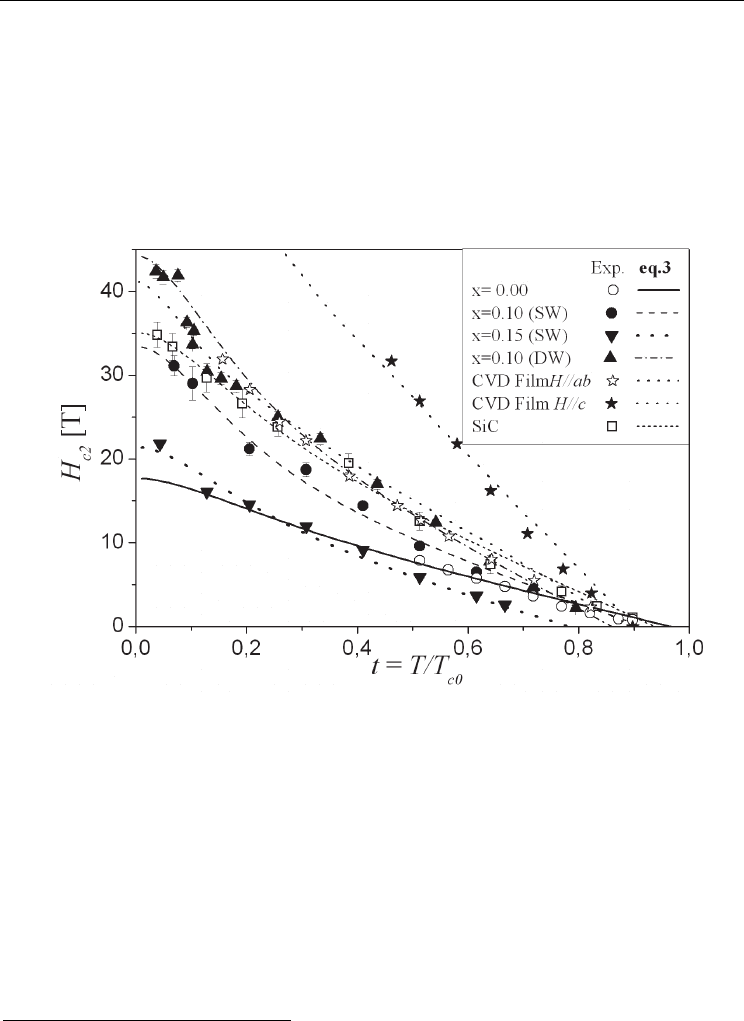
Carbon Nanotubes Addition Effects on MgB
2
Superconducting Properties
455
“dirty limit”. This effect is especially large in C-doped MgB
2
, and additionally an anomalous
H
c2
(T) upward curvature is also noted in the present data and reported many times. This
positive curvature is related to the existence of two-gaps in MgB
2
, (-band and -band) and
predicted by some theoretical models.
These models for a two gap superconductor in the dirty limit (Golubov et al., 2002;
Gurevich, 2003) consider that nonmagnetic impurities affect the intraband electron
diffusivities D
and D
, and the interband scattering rates
and
. An implicit H
c2
dependence on temperature can be obtained from the Usadel equations, derived taking into
account only the intraband effect.
Fig. 7. Transport measurements of the upper critical field (H
c2
) determined from the R(H)
curves as a function of the reduced temperature t = T/T
c0
, for selected samples with and
without CNT addition and fit to data using equation 2 (lines). Other C-doped samples are
included for comparison (Serrano et al., 2008; Braccini et al., 2005)
021
ln ln ln ln 0a t+U h t+U h a t+U h a t+U h
(2)
where,
0
/
c
tTT
is the reduced temperature
1
,
DD /
,
(1/2)-x)(1/2U(x)
,
1
In Refs. (Gurevich, 2003; Serquis et al., 2007 ; Serrano et al., 2008)) T
c0
= T
c
(g=0) is defined, where g the
interband scattering parameter. This value corresponds to the clean limit MgB
2
sample.
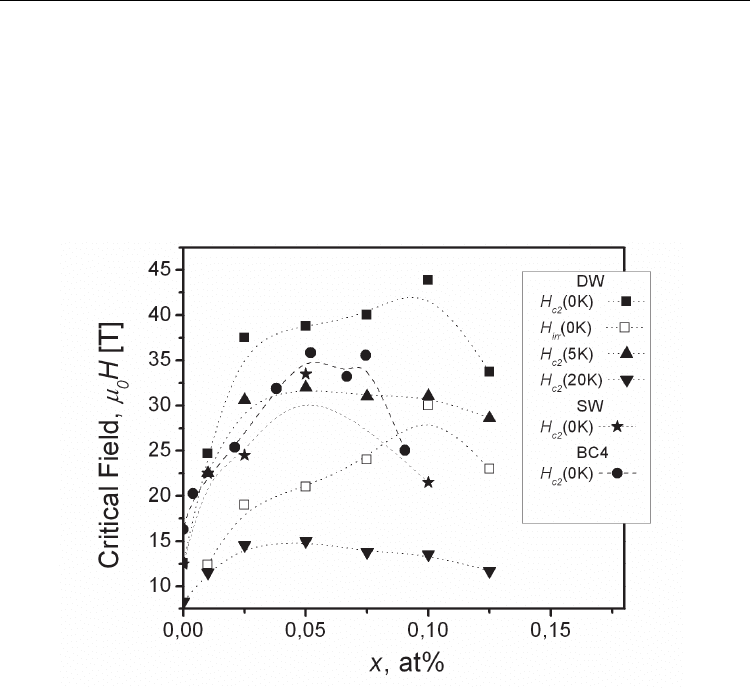
Electronic Properties of Carbon Nanotubes
456
TDHh
c 02
2/
,
07.0
93.1
7806.0
2
1
0
a
a
a
a
0
, a
1
, and a
2
were determined in ref. (Gurevich, 2003).
Another equation was derived when taking also into account the interband effects:
Fig. 8. The extrapolation at 0K of H
c2
as a function of carbon content x for DW and SW CNT
samples (full symbols). H
c2
data at 5K , 20K and H
irr
(5K) is also included for DW sample
(open symbols). Lines are only guides to the eyes.
00
2ln ln ln ln 0
ii
wtU tU tU tU
(3)
where
/22
i
,
),,,,,(
2
DDHTUU
c
,
w,
0
are constants that depend on
mn
(m,n = ,) (values obtained from ab initio
calculations) (Golubov et al., 2002; Braccini et al., 2005).
In this case we optimized the diffusivity ratio
=D
/ D
and interband scattering parameter
to fit the measurements using the equation (3).
Figure 7 shows the dependence of H
c2
as a function of the reduced temperature t = T/T
c0
,
where T
c0
= 39 K, of some selected samples with and without CNT addition. Other C-doped
samples are included for comparison (Serrano et al., 2008; Braccini et al., 2005). The lines are
fits to the data with the model proposed using the fitting parameters described above.

Carbon Nanotubes Addition Effects on MgB
2
Superconducting Properties
457
The upward curvature signaled as a characteristic of the presence of two gaps is apparent in
these H
c2
(T) data.
Figure 8 displays the H
c2
(0) extrapolations as a function of x for DW (Serquis et al. 2007) and
SW (Serrano et al. 2007) in comparison with data for other C-doped samples (Wilke et al.,
2004). We observe that H
c2
(0) increases with x and has a maximum for 10 at% for DW and 5
at% for SW. For a larger x values a decrease in H
c2
was found, probably due to a larger T
c
decrease and an increase in the resistivity of the samples. Earlier MgB
2
carbon doped data
(Wilke et al. 2005) also indicates an initial rapid rise for lower C contents that then slows
down, reaches a maximum at intermediate carbon concentrations, and decreases for larger C
contents and the same behavior was reported for MgB
2
single crystals.
The CNT additions produce a larger C incorporation than SiC, probably because of the
higher synthesis temperature, resulting in samples with lower T
c
. The DWCNT 10 at%
sample has the highest C content into the lattice, indicating that using this kind of inclusions
is an easier way to incorporate C. This allows to reach a record H
c2
value for this sample.
Earlier MgB
2
carbon doped data from Wilke et al (Wilke et al., 2005b) also indicates an
initial rapid rise for lower C contents that then slows down, reaches a maximum at
intermediate carbon concentrations, and decreases for larger C contents and the same
behavior was reported for MgB
2
single crystals. The H
c2
(0) of CNTdw10 is close to the
maximum H
c2
value as a function of x. A decrease in H
c2
(0) was also observed for a larger x
value (see Fig.8)), in agreement with other reported data (Senkowicz et al., 2007).
3. Effect of different kind of CNT addition on the superconducting properties
of MgB
2
PIT wires and tapes
The standard and low-cost fabrication powder in-tube (PIT) method involves filling a
metallic tube with superconducting powder (ex-situ) or precursors (in-situ) and drawing it
into a wire and/or rolling into a tape (Flükiger et al., 2004).
MgB
2
crystallizes in the hexagonal AlB
2
type structure (space group P6 /mmm), and the
anisotropic structure has given the motivation to investigate formation of texture by
different deformation processes. A key issue on which there is no agreement in the literature
is the optimization of the heat treatment parameters. Although some post-annealing appears
to be necessary to achieve higher J
c
,
some authors reported detrimental effects of heat
treatments in the performance of MgB
2
wires or tapes (Serquis et al., 2003; Goldacker, 2003;
Civale et al., 2003).
However, most results obtained in MgB
2
wires and tapes prepared by
PIT using different kind of CNT and treated at different temperatures using several sheath
materials (e.g. iron, stainless steel, Nb/Fe) indicate that the final sintering temperature is
very important to improve the superconducting properties allowing carbon to be
incorporated in MgB
2
.
Only one work (Xu et al., 2007) studied the influence of CNT amount, reporting the effect of
the “doping level” (x) in the field dependence of critical current density for MWCNT Fe-
sheathed MgB
2
wires and tapes. Similarly to what was reported for bulk MgB
2
samples, they
found that there is an optimum composition for all fields and temperatures studied, but the
best composition for the nominal Mg(B
1-x
C
x
)
2
was x=0.05 and J
c
decreased for x = 0.10 (see
Figure 9). However, many other researchers focused in which was considered the best
composition x=0.10 studying the influence of other parameters:
-
the effect of CNT type (Kováč et al., 2007) in comparison with other C-compounds (SiC,
graphite)
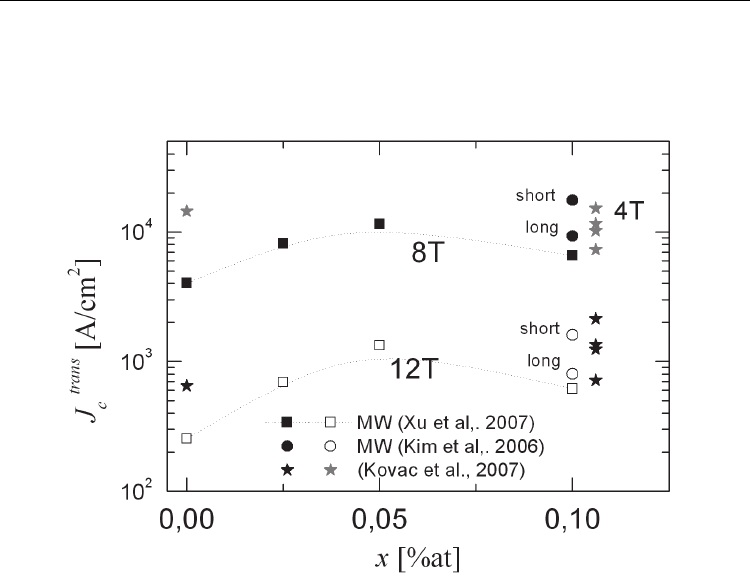
Electronic Properties of Carbon Nanotubes
458
- the effect of MWCNT size and sintering temperature (Kim et al., 2006a, 2006b, 2006c)
-
the effect of sintering temperature when using SW CNT (Kim et al., 2007)
-
the possibility of MW CNT alignment by mechanical drawing in the PIT process (Dou
et al., 2006).
Fig. 9. Critical current density as a function of MW CNT content measured by transport in
Fe-sheath Mg(B
1-x
C
x
)
2
wires at 8 T (black symbols) and 12 T (open symbols) (Xu et al., 2007).
For comparison were included data from Fe/Nb sheath tapes with 5%wt addition of
different CNT types (Kováč et al., 2007) and short and long MW CNT MgB
2
wires (Kim et
al., 2006b)
To illustrate the effect of some of the mentioned parameters we plotted in Figure 10 the
critical current density of
-
Left side: MgB
2
/Fe-Nb tapes with 5%wt addition of different CNT types (Kováč et al.,
2007). SW: Arc discharge single wall nanotubes; SW-D: Purified arc discharge single
wall nanotubes, Dry-mixed; SW-W: Purified arc discharge single wall nanotubes, Wet-
mixed; MW: Multi wall carbon nanotubes (~60 nm × 1 μm). For comparison were
included the pure (0) and a MgB
2
tapes with 5%wt addition of SiC. This last addition is
more effective in the whole field range in agreement with bulk results, while all CNT
types only enhance J
c
for high fields. The normalized current densities (shown in Figure
11) allow better comparison between the slopes of J
c
(μ
0
H), indicating a positive effect for
all additions. This field dependence enhancement is ascribed to the effect of C-
incorporation, which increases the upper critical field. The decrease of T
c
corresponding
to a higher C-doping effect can be observed in the inset of Figure 9.
-
Right side: MgB
2
/Fe wires with aligned MW CNT measured along (a) and
perpendicular (c) to the wire (Dou et al., 2006). While the pure sample has little
differences between both measurement field directions, there is a clear difference in
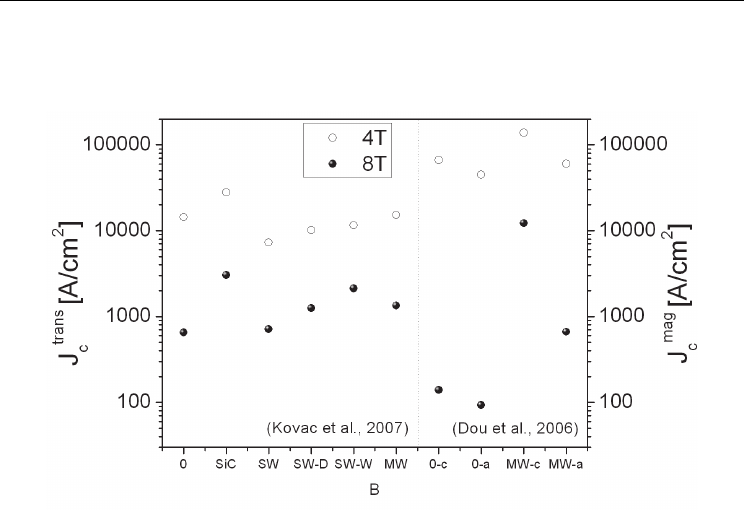
Carbon Nanotubes Addition Effects on MgB
2
Superconducting Properties
459
samples with MW addition, which increased with field. This is a good indication that
CNTs could be aligned along the longitudinal axis of the MgB
2
wires by mechanical
drawing in the PIT process.
Fig. 10. (Left) Critical current density measured by transport in MgB
2
/Fe-Nb sheath tapes
with 5%wt addition of different CNT types (Kováč et al., 2007) at 8 T (black symbols) and 4
T (open symbols). (Right) Critical current density measured by magnetization in Fe sheath
MgB
2
wires with aligned MW CNT measured along (a) and perpendicular (c) to the wire
(Dou et al., 2006)
Matsumoto (Matsumoto et al., 2006) reported that J
c
in SiC-alloyed MgB
2
tapes depends on a
complex relation between grain connectivity, H
c2
, and flux pinning induced by grain
boundaries and precipitates. However, the distinct effect of C incorporation through
different routes in J
c
and H
c2
is still not entirely understood.
Matsumoto et al reported a similar H
c2
(0) to our record value for a SiC-doped MgB
2
tape
prepared by the PIT method. These results correspond to a PIT tape sample that probably
has some texturing and the reported H
c2
data was measured with the applied field parallel
to the tape. Since we measured randomly oriented polycrystalline bulk samples, our results
cannot be easily compared with Matsumoto’s.
4. Effect of CNT addition on the magnetic relaxation of MgB
2
4.1 Introduction
In Section 2.2 we have shown that the main effect of DW CNTs addition is the simultaneous
increase in the critical current density and the upper critical field H
c2
. However, it is not
clear if these two effects are connected. In fact, the vortex physics underlying this
performance improvement has not been so far understood. In this section, we present a
very recent work (Pasquini et al., 2011), where the role of CNT addition is investigated by
studying the magnetic relaxation in bulk MgB
2
samples.
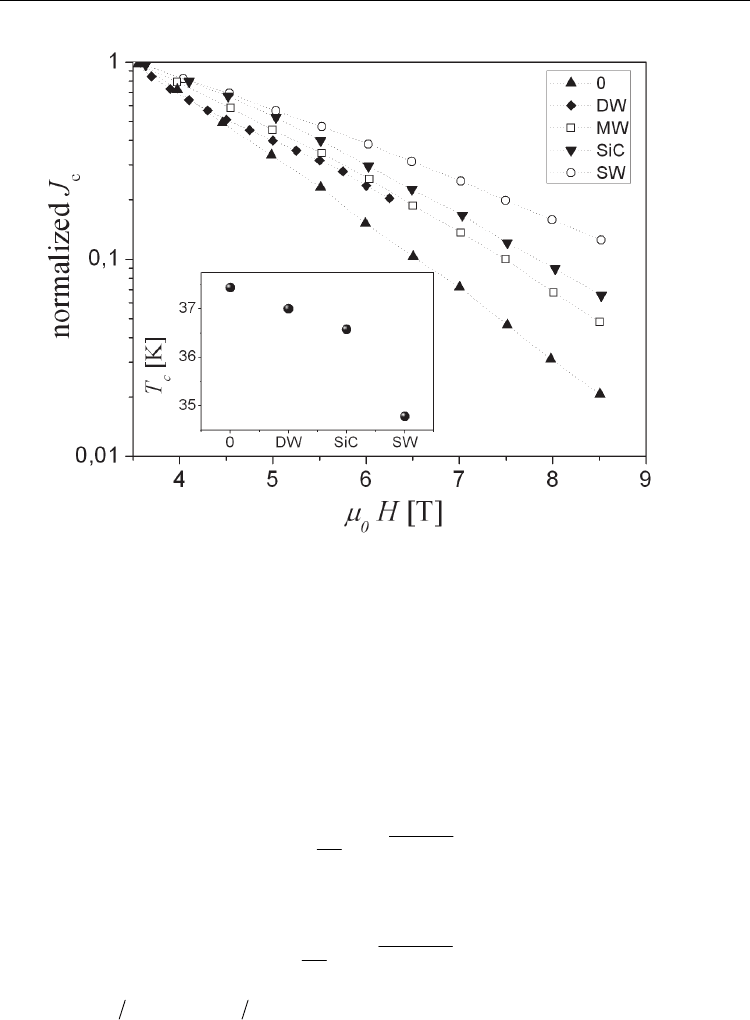
Electronic Properties of Carbon Nanotubes
460
Fig. 11. Normalized critical current densities J
c
(μ
0
H)/J
c
(3.5 T) showing the difference in slope
for a pure sample and MgB
2
tapes with 5%wt addition of different CNT types (Kováč et al.,
2007), including a DW with similar content (Serquis et al., 2011). The inset shows the T
c
of
the same tapes.
As was mentioned in Section 2.1.1, if a superconducting sample is fully penetrated by the
magnetic field B, the magnetization m is proportional to the density current J flowing in the
sample that, in the ideal critical state approximation is the critical current density J
c
.
However, due to the thermal activated motion, this "measurable" critical current is lower
than the "true" J
c0
. The main quantity governing the creep of vortices is the activation barrier
U(J,T,B). In a magnetic relaxation experiment both the magnetization m and J
c
decay in time
as
(,,)
c
UJ TB
c
kT
j
J
Ce
t
and then
()
(,,)
m
U
j
TB
kT
m
m
Ce
t
(4)
where
0
~
cc
CJ
or
0
~
m
Cm
can be approximated as constants.
The activation barrier is expected to be described by the general expression (Blatter et
al.,1994; Geshkenbein et al., 1989)

Carbon Nanotubes Addition Effects on MgB
2
Superconducting Properties
461
0
(,) (,)
(; ; ) [( ) 1]
cc
UTB J TB
UJTB
J
(5)
where U
c
(T,B) is the pinning energy and μ is a critical exponent characteristic of the
particular creep regime.
In High Temperature Superconductors (HTSs), the creep drastically reduces the measured
current density, so J
c
<<J
c0
. A large number of glassy creep regimes in this limit have been
proposed theoretically (Blatter et al., 1994; Yeshurum et al., 1996) and many of them
observed experimentally (Thompsom et al., 1994, 1997), where ( , , ) ( , )UJTB
g
TBJ
.
In those cases the temperature dependence of the measurable J
c
is dominated by creep while
the J
c0
(T) dependence is negligible. On the other hand, in traditional type II superconductors
the current decay is very small, so (J
c0
-J
c
)<<J
c0
, therefore equation (5) take the traditional
Anderson-Kim (A-K) linear dependence (Anderson et al., 1964)
0
(, , ) ( , )(1 )
(,)
c
c
J
UJTB U TB
JTB
(6)
In these very low creep superconductors an experimental confirmation of glassiness, which
regardless of the specific approach always involves detecting tiny deviations from the
Anderson-Kim model, is extremely challenging.
From this basic point of view, MgB
2
is a very particular system, as the intermediate T
c
and
moderate anisotropy makes the creep effects smaller than in HTS but larger than in
conventional superconductors. The influence of thermal fluctuations in the vortex physics is
measured by the Ginzburg number G
i
=(1/2)(kT
c
/H
c
²ξ³γ
-
¹)². For YBa
2
Cu
3
O
7-
this is as large as
G
i
~ 10
-2
, and even larger for the more anisotropic Bi-based compounds, while for NbTi, the
paradigmatic strong-pinning conventional superconductor, G
i
~10
-8
. For MgB
2
, depending
on the doping level we have G
i
~10
-4
-10
-5
. This is just in the middle between the extreme
cases. The first consequence is that in magnetization measurements, the A-K limit is not
necessary valid in the whole temperature range, and the measured J
c
is expected to be in the
intermediate range (J
c0
-J
c
)≲J
c
.
In the rest of the section we present a creep study in bulk MgB
2
samples as-grown and
doped with different doses of carbon nanotubes. In subsection 4.2 experimental relaxation
rates are presented, and the general behaviour is described. In subsection 4.3 we review
some fundamental concepts and formulas concerning creep rates and activation energies to
perform in subsection 4.4 a careful analysis of results that allows us to identify the region
where the A-K model is valid. In 4.5, the pinning energies U
c
, true critical current densities
J
c0
, and correlation volumes V
c
are estimated and compared. Conclusions are summarized
in 4.6.
4.2 Relaxation rates
Samples used in this study were prepared by solid-state reaction with magnesium (-325
mesh, 99%) and amorphous boron (99%) as starting materials (Serrano et al., 2008). The
powders were ground inside a glove box and pressed under 500 MPa into small pellets with
dimensions of 6 mm in diameter and 4 mm in thickness, wrapped together with extra 20%at
Mg turnings (99:98% Puratronic) in Ta foil and then placed in an alumina crucible inside a
tube furnace in flowing Ar=H
2
at 900C for 30 min.

Electronic Properties of Carbon Nanotubes
462
The relaxation measurements were carried out in a Quantum Design model MPMS XL 7T
SQUID based magnetometer. Time-dependent data were taken with a protocol similar to
that described in ref. (Civale et al., 1996). A scan length of 3 cm was used in order to
minimize the effects due to the non-uniformity of the applied magnetic field that was
applied parallel to the longest axis of the sample. For each relaxation measurement, the
samples were first cooled and stabilized at the measurement temperature. Then the field
was first raised up to 6T and then lowered to the measuring field to assure that the sample
was fully penetrated. Intermediate measurements were performed in the upper and lower
magnetization branches to subtract the reversible magnetization. We checked for and ruled
out any effects due to the magnet self relaxations (H variations during the measurement
time) that could lead to spurious changes in the magnetization of the samples.
The experimental critical current density J
c
(t) has been calculated from the measured
magnetic moment using equation (1), as in previous sections.
As reported in section 2.2., the response for samples with DWCNT additions between 1%
and 10% at temperature far below T
c
is very similar and the "measured" critical current
density J
c
is optimal in this range of doping. This fact is illustrated in Figure 3, where J
c
obtained from typical magnetization loops in samples with different doses of DWCNT is
plotted as a function of the applied magnetic field H at T = 5K and 20K . The response for
samples with 1 at% and 10 at% addition of DWCNT is very similar. At low temperature (5
K), CNT addition enhances J
c
more than twice for all the measured range of H. On the other
hand, at high temperature (20 K) the response of pure and CNT samples is quite similar but
CNT addition continues being efficient at fields higher than H = 2T.
The magnetic relaxation has been measured in pure MgB
2
samples and samples with
DWCNT doses between 1 at% and 10 at% in the range between 5K and 25K. The
corresponding relaxation rate S=-d(ln(J))/d(ln(t)) has been obtained as the slope of the ln J vs
ln t graph. Results for H =1T (full symbols) and 3T (open symbols) are shown in Figure 12.
Samples with doses of 2.5% and 5% of carbon nanotubes have also been measured and
display similar results, not shown in the figure for clarity.
As was described in the introduction, the S values are intermediate between those measured
in low and high T
c
materials. With this moderate relaxation, the temperature dependence of
J
c
(t) (Figure 3) cannot be explained assuming a T independent J
c0
at low temperature. An
intrinsic J
c0
(T) dependence must to be taken into account.
Again, at H = 1 T the decay in time is quite similar in all the doped samples with doses
between 1% and 10%. However, same unexpected results appear. The S(T) curve at H=3T is
similar for pure and CNT samples in all the temperature range. Furthermore, at H=1T the
pure sample that has a lower J
c
(associated with a lower pinning) has also a lower relaxation
(associated with a higher pinning energy U
c
).
We have proceeded to analyze the relaxation data in a pure and a 10 at% CNT samples to
get an understanding of the causes of this puzzle. The procedure and results are described
in the subsections 4.3 and 4.4.
4.3 Creep and activation energies in the Anderson-Kim approximation
In the general case (Blatter et al., 1994), the relaxation rate S is related with the pinning
energy by
00
(,) (,)
1
ln(1 ) ~ ln( )
cc
UTB UTB
tt
tt
SkT kT
(7)
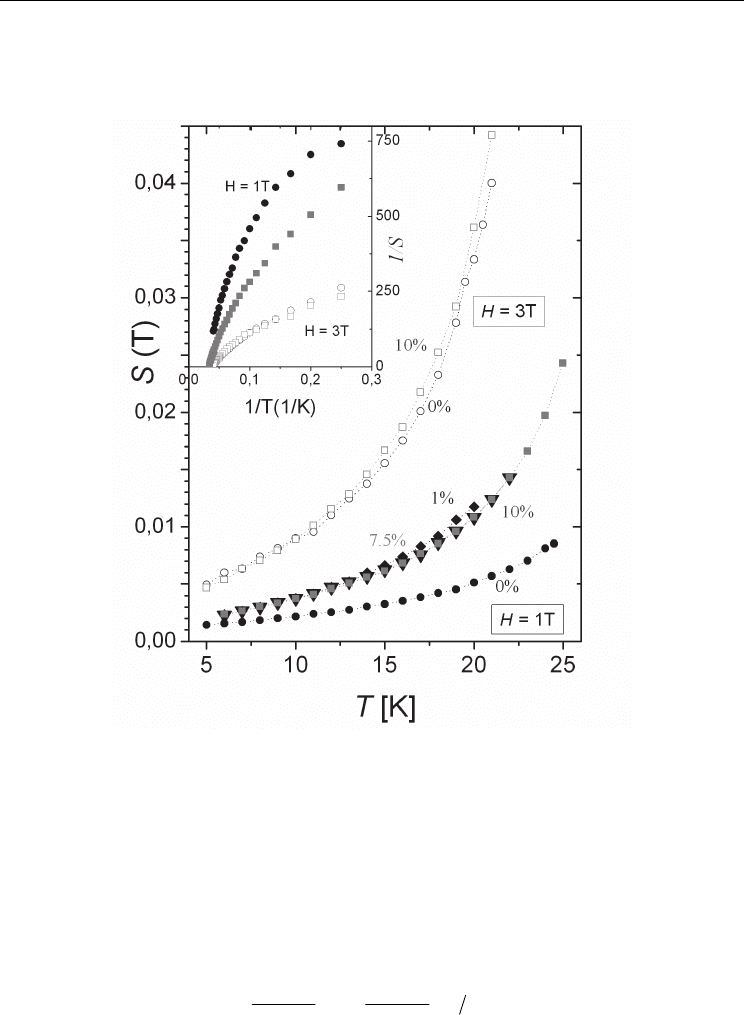
Carbon Nanotubes Addition Effects on MgB
2
Superconducting Properties
463
if
0
tt . This expression should be valid in all the current range, including the A-K limit.
Therefore, if U
c
is T independent at low temperatures, a linear relationship between 1/S and
1/T is expected.
Fig. 12. Relaxation rate S as a function of temperature for a pure MgB
2
sample (circles) and
for samples with different doses of DWCNT: 1% (diamonds), 7.5% (triangles) and
10%(squares) at H = 1 T (full symbols) and H = 3T (open symbols). In the inset, the plot of
1/S vs. 1/T reveals that it is not possible to assume a temperature independent pinning
energy at low temperature in all the cases.
As was mentioned in the introduction, the A-K approximation assumes
00
()
cc
JJ J or
0
(/ )~1
c
JJ , that lets to the linear dependence of eq. (6) between the activation barrier U
and the density current J. The integration of eq. (4) in this limit gives the well known
logarithmic decay of the experimental critical current density with time.
()
~[1 ln( )]
(,) (,)
c
o
co c
kT
Jt
tt
JTB UBT
(8)
and allows to estimate
(,)/
c
UTB kT
under the supposition that
0
~
c
JJ
.
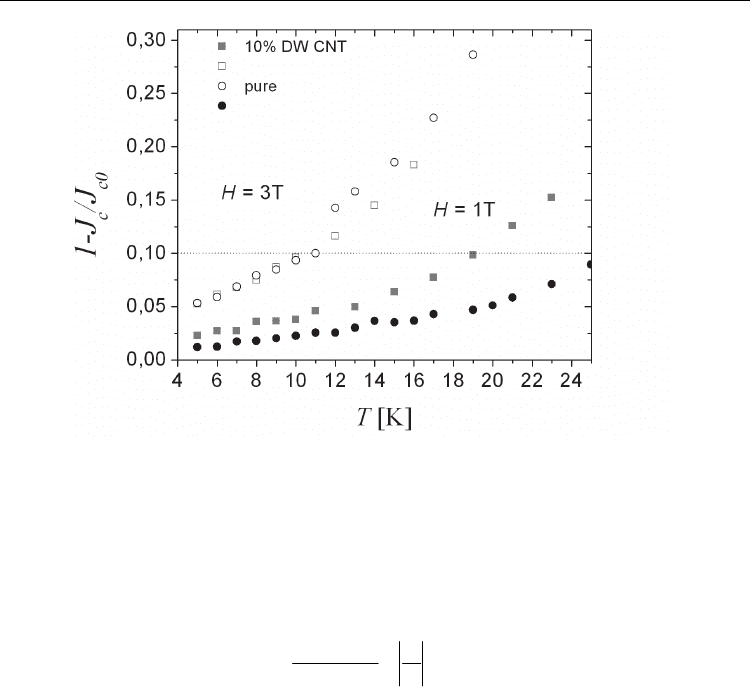
Electronic Properties of Carbon Nanotubes
464
Fig. 13. Ratio
J/ J
c0
as a function of temperature for pure (circles) and 10% CNT (squares)
samples at H = 1T (full symbols) and H=3T (open symbols).
J = J
c0
– J
c
is the difference
between the estimated “true” critical current density (see text) and the measured critical
current density. A criterion of 10% (doted line) has been taken to validate the A-K
approximation
J <<J
c0
.
An alternative method combines eqs. (4) and (6) to obtain a linear dependence between J
and ∂J/∂t that, under the condition ln ( , ) /
Jc
CUTBkT
results in (Pasquini et al., 2011)
(,)
() ln ( , )
(, )
co
cco
c
kT J T B
dJ
Jt J TB
UtB dt
(9)
Due to the numerical differentiation, this method has a greater error in the calculation of the
pinning energy, but allows estimating J
c0
(B,T).
A mayor difficulty to directly decide the validity of the A-K approximation from the
relaxation data at a single temperature is the extremely large time needed to reliably
determine the linear relationship (8) (i.e. the logarithmic decay with time of the current
density). However, the resulting fitting parameter J
c0
(B,T) must be consistent with the A-K
assumption
0
(/ )~1
cc
JJ and the resulting fitting parameter (,)
c
UTB must be consistent
with eq. (7). If these two conditions are not fulfilled then some of the assumptions was
wrong and we can conclude that the AK description is not valid.
In the following section, we apply the above procedure to MgB
2
relaxation data,
determining the temperature region where results are consistent.
4.4 Data analysis in MgB
2
samples
As can be observed in the inset of Figure 12, it is not possible to identify in all the cases a
low T region with a linear relationship between 1/S and 1/T, characteristic of a temperature
independent pinning energy. For this reason, experimental data where separately analysed
